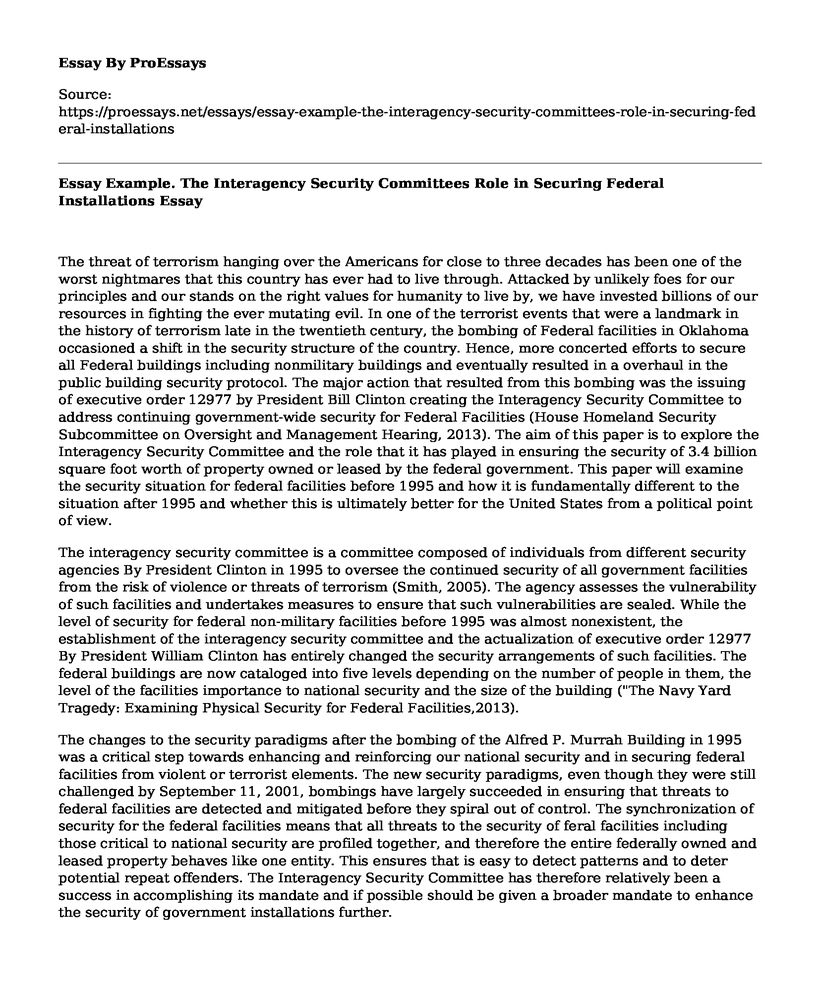The threat of terrorism hanging over the Americans for close to three decades has been one of the worst nightmares that this country has ever had to live through. Attacked by unlikely foes for our principles and our stands on the right values for humanity to live by, we have invested billions of our resources in fighting the ever mutating evil. In one of the terrorist events that were a landmark in the history of terrorism late in the twentieth century, the bombing of Federal facilities in Oklahoma occasioned a shift in the security structure of the country. Hence, more concerted efforts to secure all Federal buildings including nonmilitary buildings and eventually resulted in a overhaul in the public building security protocol. The major action that resulted from this bombing was the issuing of executive order 12977 by President Bill Clinton creating the Interagency Security Committee to address continuing government-wide security for Federal Facilities (House Homeland Security Subcommittee on Oversight and Management Hearing, 2013). The aim of this paper is to explore the Interagency Security Committee and the role that it has played in ensuring the security of 3.4 billion square foot worth of property owned or leased by the federal government. This paper will examine the security situation for federal facilities before 1995 and how it is fundamentally different to the situation after 1995 and whether this is ultimately better for the United States from a political point of view.
The interagency security committee is a committee composed of individuals from different security agencies By President Clinton in 1995 to oversee the continued security of all government facilities from the risk of violence or threats of terrorism (Smith, 2005). The agency assesses the vulnerability of such facilities and undertakes measures to ensure that such vulnerabilities are sealed. While the level of security for federal non-military facilities before 1995 was almost nonexistent, the establishment of the interagency security committee and the actualization of executive order 12977 By President William Clinton has entirely changed the security arrangements of such facilities. The federal buildings are now cataloged into five levels depending on the number of people in them, the level of the facilities importance to national security and the size of the building ("The Navy Yard Tragedy: Examining Physical Security for Federal Facilities,2013).
The changes to the security paradigms after the bombing of the Alfred P. Murrah Building in 1995 was a critical step towards enhancing and reinforcing our national security and in securing federal facilities from violent or terrorist elements. The new security paradigms, even though they were still challenged by September 11, 2001, bombings have largely succeeded in ensuring that threats to federal facilities are detected and mitigated before they spiral out of control. The synchronization of security for the federal facilities means that all threats to the security of feral facilities including those critical to national security are profiled together, and therefore the entire federally owned and leased property behaves like one entity. This ensures that is easy to detect patterns and to deter potential repeat offenders. The Interagency Security Committee has therefore relatively been a success in accomplishing its mandate and if possible should be given a broader mandate to enhance the security of government installations further.
References
House Homeland Security Subcommittee on Oversight and Management Hearing. (2013). Report Information from ProQuest. Retrieved from http://homeland.house.gov/sites/homeland.house.gov/files/documents/Testimony-Goldstein.pdf
Smith, S. (2005). The Interagency Security Committee and Security Standards for Federal Buildings. CRS Report for Congress.
Written testimony of NPPD Office of Infrastructure Protection for a Senate Committee on Homeland Security and Governmental Affairs hearing titled "The Navy Yard Tragedy: Examining Physical Security for Federal Facilities. (2013). Report Information from ProQuest. Retrieved from https://search.proquest.com/docview/1468945162?accountid=8289
Cite this page
Essay Example. The Interagency Security Committees Role in Securing Federal Installations. (2021, Apr 26). Retrieved from https://proessays.net/essays/essay-example-the-interagency-security-committees-role-in-securing-federal-installations
If you are the original author of this essay and no longer wish to have it published on the ProEssays website, please click below to request its removal:
- Essay on Body Cameras on Police Officers
- Essay on Blessed Homeless Shelter
- Change in Women Representation Essay
- What Can School Staff Do to Prevent Bullying? - Essay Sample
- Research Paper on Discrimination Based on Sexual Orientation: What It Is and Why It's Wrong
- Free Essay Example on Gun Violence in America: An Alarming Reality
- Case Study Sample on Mr. Moore Arrested & Charged Despite No Grounds: Conviction Reversed







